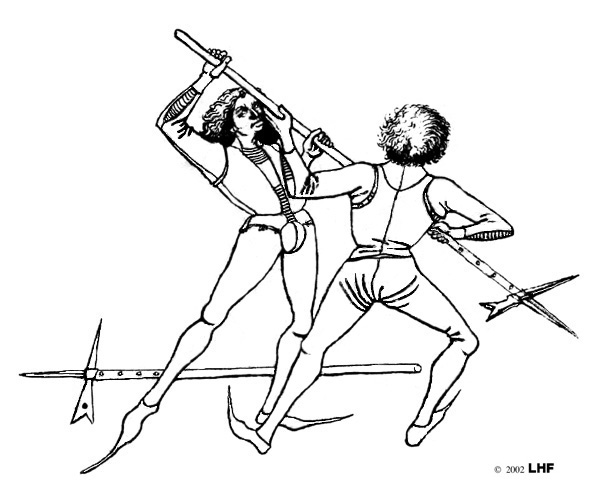 Here is
an example of a man's doublet from a style found in
Swabia, occupying present day south-western Germany, eastern Switzerland, and Alsace during the third quarter of the fifteenth century. Variations in the pattern
of this swäbisch doublet include the shape of the
yoke of its collar, which could vary from a shallow round shape to more of a
pointed triangle, (fig b),
and also the shape and attachment of the sleeves. Generally,
it appears to be
made with four panels extending to about mid-hip level with the point holes for the hose found near
the lower edge of the peplum. Some, it should be noted, exhibit a seam line separating the
peplum from the upper body indicating an eight piece construction for the doublet
body. As the top of the hose rose to the natural waistline with the
progression of the century, the bottom hem line of the peplum rose to match
it. Compare with an example from the end of the
fifteenth century, the peplum appears as only a thin strip below the
waist, full of holes for the purpose of pointing, (fig
a). It should be noted that by century's end there were other
significant differences in construction and one should take care not to meld one
style with the other.
Here is
an example of a man's doublet from a style found in
Swabia, occupying present day south-western Germany, eastern Switzerland, and Alsace during the third quarter of the fifteenth century. Variations in the pattern
of this swäbisch doublet include the shape of the
yoke of its collar, which could vary from a shallow round shape to more of a
pointed triangle, (fig b),
and also the shape and attachment of the sleeves. Generally,
it appears to be
made with four panels extending to about mid-hip level with the point holes for the hose found near
the lower edge of the peplum. Some, it should be noted, exhibit a seam line separating the
peplum from the upper body indicating an eight piece construction for the doublet
body. As the top of the hose rose to the natural waistline with the
progression of the century, the bottom hem line of the peplum rose to match
it. Compare with an example from the end of the
fifteenth century, the peplum appears as only a thin strip below the
waist, full of holes for the purpose of pointing, (fig
a). It should be noted that by century's end there were other
significant differences in construction and one should take care not to meld one
style with the other.
The sleeves
are of special interest and exhibit a stunning variety in design, (fig
c). They can either be sewn or attached by points to the doublet. The sleeves can
also be completely closed down to the wrist, open only at the elbow, or
have an opening reaching from the wrist to almost the
armpit. With the last variation, the
opening appears to be held closed at the wrist
and at intervals along the opening by points. In some
illustrations an additional slit is cut on the upper sleeve near the sleeve
head, (fig. d). This may be to aid
in movement? The sleeve seam appears to match the
side seam of the doublet body in many of the illustrations. This may represent one possible
form of construction. I offer
this pattern as a template for
one historically plausible sleeve and
doublet reconstruction.
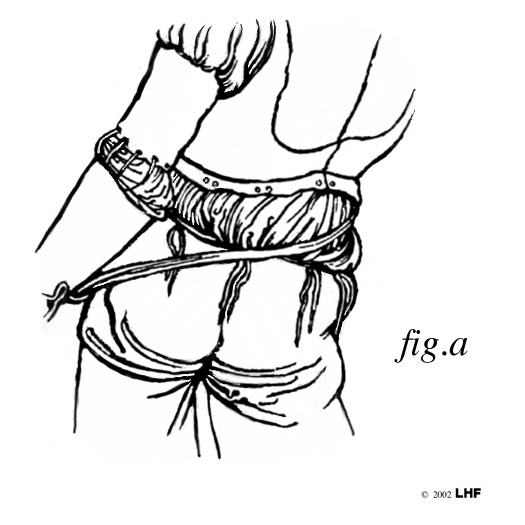
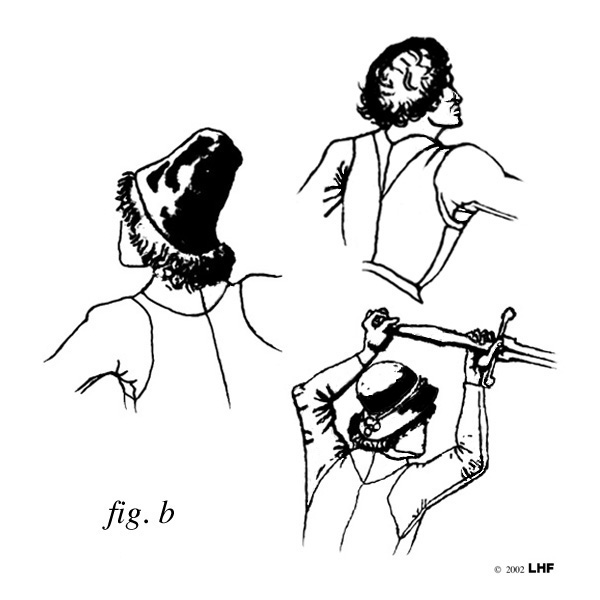
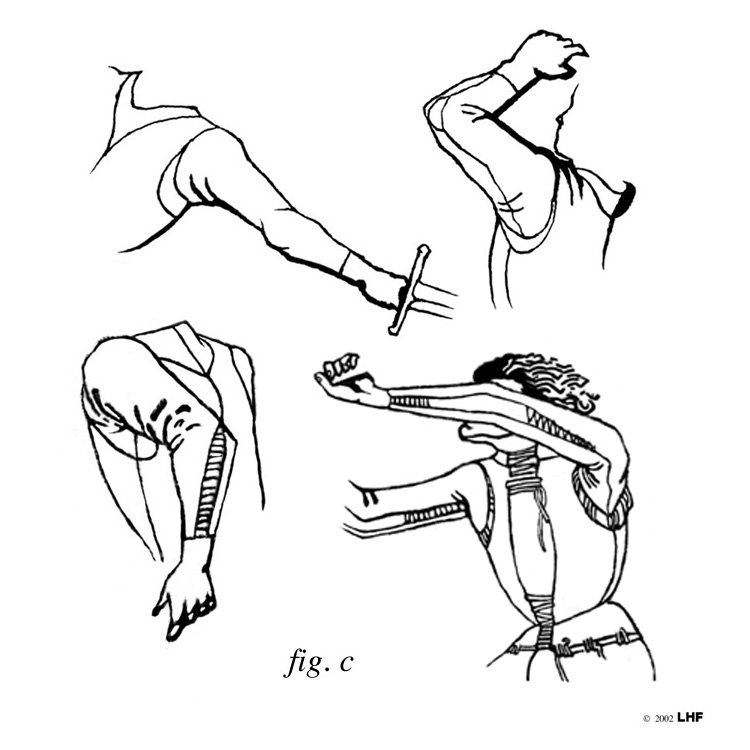
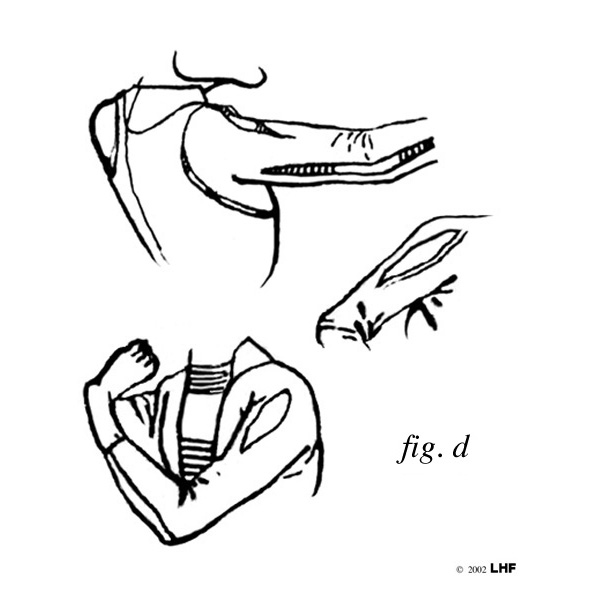
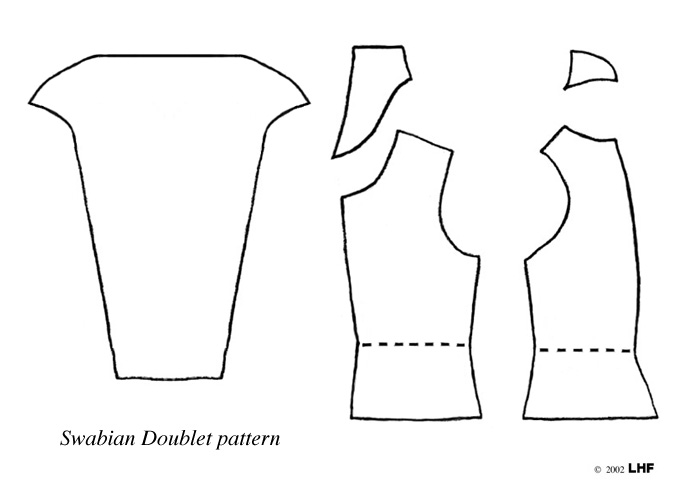
Images,
with the exemption of fig. a and swabian doublet pattern, were taken from Talhoffers
Fechtbuch: Gerichtliche und andere Zweikampfe darstellend, Anno Domini 1467. They
are listed in clockwise order starting from top: title image, tafel
93;
fig. b, tafel 224, 3, 98; fig. c, tafel 239, 100, 48, 82; fig. d,
tafel 64,
201,201. fig. a was taken from The Martyrdom of S. Catherine B.
120. H. 1883. R. 22. D. 7., ca. 1498. swäbisch doublet pattern was
created by LHF,
2002.
 Here is
an example of a man's doublet from a style found in
Swabia, occupying present day south-western Germany, eastern Switzerland, and Alsace during the third quarter of the fifteenth century. Variations in the pattern
of this swäbisch doublet include the shape of the
yoke of its collar, which could vary from a shallow round shape to more of a
pointed triangle, (fig b),
and also the shape and attachment of the sleeves. Generally,
it appears to be
made with four panels extending to about mid-hip level with the point holes for the hose found near
the lower edge of the peplum. Some, it should be noted, exhibit a seam line separating the
peplum from the upper body indicating an eight piece construction for the doublet
body. As the top of the hose rose to the natural waistline with the
progression of the century, the bottom hem line of the peplum rose to match
it. Compare with an example from the end of the
fifteenth century, the peplum appears as only a thin strip below the
waist, full of holes for the purpose of pointing, (fig
a). It should be noted that by century's end there were other
significant differences in construction and one should take care not to meld one
style with the other.
Here is
an example of a man's doublet from a style found in
Swabia, occupying present day south-western Germany, eastern Switzerland, and Alsace during the third quarter of the fifteenth century. Variations in the pattern
of this swäbisch doublet include the shape of the
yoke of its collar, which could vary from a shallow round shape to more of a
pointed triangle, (fig b),
and also the shape and attachment of the sleeves. Generally,
it appears to be
made with four panels extending to about mid-hip level with the point holes for the hose found near
the lower edge of the peplum. Some, it should be noted, exhibit a seam line separating the
peplum from the upper body indicating an eight piece construction for the doublet
body. As the top of the hose rose to the natural waistline with the
progression of the century, the bottom hem line of the peplum rose to match
it. Compare with an example from the end of the
fifteenth century, the peplum appears as only a thin strip below the
waist, full of holes for the purpose of pointing, (fig
a). It should be noted that by century's end there were other
significant differences in construction and one should take care not to meld one
style with the other. 



